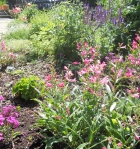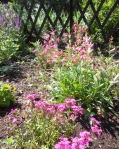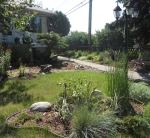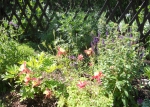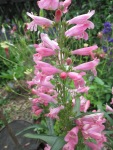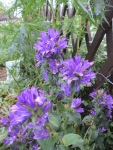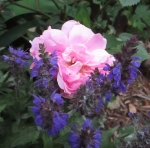- Penstemon digitalis Beardtongue 12 July ’14
- 12 July ’14
- 12 July ’14 verbena, pink beard tongue, salvia nemorosa
- 12 July ’14 Blue oat grass, Karl Foerster Feather Reed Grass, dogwood, tricolor ribbon grass, Maltese Cross
- Weigala 12 July ’14
- 12 July ’14 globe flower, fox glove, California poppies, creeping thyme, sweet grass,
- sedum 12 July ’14
- snow-in-summer, salvia nemorosa, weigala, lavender, 12 July ’14
- Salvia nemorosa, snow-in-summer, lavender 12 July ’14
- 12 July 2014 Canada Columbine, Salvia nemorosa Marcus™, clustered bellflower
- Beardtongue July 16, 2013
- Sedum rupestre Stonecrop Blue Spruce
- Delphineum Light Blue July 30, 2013
- Globeflower July 13, 2013
- Maltese Cross 25 July ’11 Lychnis coronari
- Nova Scotia Rose July 13, 2013
- Bee Balm July 16, 2013
- Dwarf Clustered Bellflower July 23, 2014
- John Davis Explorer Rose
- Foxglove 9 July 2013
- Morden Sunrise July 6, 2011
 |
The numbers in this image taken 25 July 2011, refer to the list of individual plants in my garden on this page. |
 |
The numbers in this image taken 25 July 2011, refer to the list of individual plants in my garden on this page. |
Mid-summer cutting back
See this useful site on Deadheading perennials I have referred to their list and their advice for plants in my own garden.
In my garden some perennials like Lamium need constant cutting back even during winter chinooks and late winter. Lamium, creeping veronica, creeping thyme, creeping phlox can be divided and transplanted in my garden in almost any season.
The stems of spent flowers on early bloomers like armeria (Sea Pink, Common Thrift) can be cut back and they may rebloom sporadically.
If I can catch the right timing with the Cransebill geraniums, Avens, achillea (Yarrow), wind anemones in late June or early July, cutting back encourages a late season bloom and keeps them tidier. I clip the alyssum compactum and the Royal Wedding Poppy back because it just looks too messy after they have bloomed.
For some perennials like arabis(Rockcress) and Snow-in-summer, cutting back the flowers after flowering will encourage denser, neater foliage. They will not rebloom. Left on its own without cutting back, snow-in-summer is attractive to garden slugs. Snow-in-summer can be divided and transplanted in my garden in almost any season although the hottest part of summer is the most challenging for any plant divisions.
For some perennials like columbines, it is better to wait until the foliage fails before cutting it back although dead-heading for more blooms is recommended. These plants will not have a second late season bloom.
Some varieties of some perennials like delphineum (Larkspur) may rebloom. They benefit from removal of spent flowers and the stem can be cut back to a leaf bud to encourage side shoots.
There are some plants like artemesia (Wormwood, Sagebrush, Prairie Sage) and yarrow with ample foliage that I cut back frequently even in late June as it will regrow. Yarrow will reflower but Prairie Sage won’t. Prairie Sage smells great in the compost. If I wait too long it is leggy and unsightly. This plant is used in First Nation’s smudging ceremonies.
Mid-summer cutting back
See this useful site on Deadheading perennials I have referred to their list and their advice for plants in my own garden.
In my garden some perennials like Lamium need constant cutting back even during winter chinooks and late winter. Lamium, creeping veronica, creeping thyme, creeping phlox can be divided and transplanted in my garden in almost any season.
The stems of spent flowers on early bloomers like armeria (Sea Pink, Common Thrift) can be cut back and they may rebloom sporadically.
If I can catch the right timing with the Cransebill geraniums, Avens, achillea (Yarrow), wind anemones in late June or early July, cutting back encourages a late season bloom and keeps them tidier. I clip the alyssum compactum and the Royal Wedding Poppy back because it just looks too messy after they have bloomed.
For some perennials like arabis(Rockcress) and Snow-in-summer, cutting back the flowers after flowering will encourage denser, neater foliage. They will not rebloom. Left on its own without cutting back, snow-in-summer is attractive to garden slugs. Snow-in-summer can be divided and transplanted in my garden in almost any season although the hottest part of summer is the most challenging for any plant divisions.
For some perennials like columbines, it is better to wait until the foliage fails before cutting it back although dead-heading for more blooms is recommended. These plants will not have a second late season bloom.
Some varieties of some perennials like delphineum (Larkspur) may rebloom. They benefit from removal of spent flowers and the stem can be cut back to a leaf bud to encourage side shoots.
There are some plants like artemesia (Wormwood, Sagebrush, Prairie Sage) and yarrow with ample foliage that I cut back frequently even in late June as it will regrow. Yarrow will reflower but Prairie Sage won’t. Prairie Sage smells great in the compost. If I wait too long it is leggy and unsightly. This plant is used in First Nation’s smudging ceremonies.”]
Gardening to do list mid-July:
July is the time for adding more compost to the beds. Roses and some of the other flowering plants need more fish fertilizer. I can never have enough mulch. It would have been better if more mulch had been added before the July heat.
The Prairie Sage is flowering. The clusters of small yellow blossoms become untidy quickly and the stalks too weak to stand alone. They can be easily pulled out to the roots or cut back. I love the smell of mugwort and it is great for the compost. But it leans on other plants and takes a lot of room. The Calgary Horticultural Society recommends the Powderface Willow in their Native Plant Portrait in their October/November 2013 issue. It is a tidy plant that can also replace the Wolf Willow (Silverberry). It is available at Bow Point Nursery in the Calgary area.
Daisies are blooming in abundance and they also need support.
The cranesbill geranium are almost ready to be pruned right back so they can bloom again. Horticulturalist John Valleau recommends hard pruning perennials like Cranesbill Geraniums (just above the ground), Silver Mound Artemisia (2 inches in height), Lady’s Mantle (Alchemilla), Old-fashioned Bleedingheart (Dicentra spectabilis), Chrome Spurge (Euphorbia polychroma), Catmint (Nepeta), Blue Salvia, Meadow-rue (Thalictrum), Spiderwort (Tradescantia).
Bachelor’s buttons are also looking ungainly. I planted them in areas that I was just developing. Now that I know how well things grow in these spaces I will be replacing the Bachelor’s Buttons. They are good filler plants and the leaves are not ugly but they do need work with either pruning and/or support and they can become invasive.

